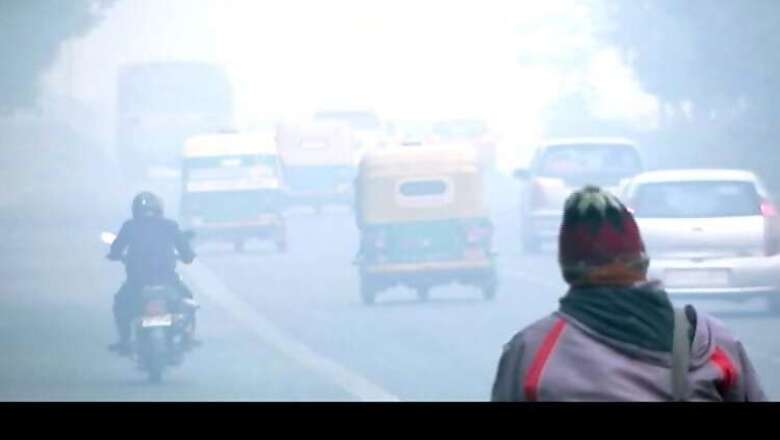
views
About 80% of Indian cities violate the prescribed standards of air quality and expose their population to dangerous air pollutant levels. Pollutant levels in 56% cities are more than 1.5 times these annual average standards.
Delhi’s air quality is in the limelight because the annual averaged concentrations of particulate matter are more than 4 times the prescribed standards and more than 12-15 times the WHO guideline value. About 6 lakh mortalities in India and thousands in Delhi die annually because of deteriorated air quality.
TERI estimates show that in a business as usual scenario the mortalities due to air pollution in India can increase to 11 lakhs annually by 2030. While the primary concern is human health, air pollutants react to form secondary pollutants like ozone which also have significant impact over agricultural productivity. Upto 36% of wheat is estimated to be lost due to ozone pollution in India.
A capital city like Delhi, with very high population growth rates and urban sprawl, has to deal with multiplicity of environmental problems. Air quality in the city was critically bad during late 1990s when a number of measures were taken for improvement.
Since then it has always been a battle between growing population linked economic activities (leading to demands for mobility, energy and products) and emission control interventions. During 2002-2007, emission control measures like introduction of newer vehicle emissions and fuel quality norms, cleaner fuels, banning of older vehicles, shifting of industries, did not allow the growing economic activities to further deteriorate the air quality.
However, since then the unprecedented demands for energy within the city and in the surrounding towns have pushed the PM concentrations in Delhi well above the levels of nineties. The problem which was restricted to Delhi city has now become a larger problem of the whole NCR region. TERI simulations show that it is not just Delhi which is heavily polluted but the air quality has also deteriorated in the larger region.
The sheer growth of the overall National Capital Region (NCR) in last 10 years has negated the effects of interventions in the past in Delhi for air quality control. Evidently, the measures for air quality control have not been proactively taken to account for future growth. Conclusively, a region like NCR demands regular assessments (every five years) like source apportionment studies for proactive planning and control of air pollution.
Currently, vehicular sector and contributions from surrounding town are the two prominent causes of pollution levels in the city. The number of vehicles in the city of Delhi has just doubled in last one decade.
Other than more than 8 million vehicles in the city, there are another 5 million registered vehicles in other parts of NCR. This upsurge in the ownership of private vehicles is due to limited public transport system which is also not considered absolutely safe and reliable.
It is not just vehicles numbers have increased; there is a clear shift towards diesel based bigger cars which require more road space and off course lesser systemic operational efficiencies, and pollution.
Adding to the problem, there is no further advancement on fuel quality and vehicular emission standards since 2010 when BS-IV was introduced. Sadly, due to differentiated auto fuel policy, heavy duty trucks which contribute maximum to the emissions, still ply on inferior BS-III standards despite the fact that Delhi has moved to BS-IV vehicular standards in 2010.
Finally, the whole country is expected to move to BS-V norms in 2019. Other than newer vehicle, we have also not improved and strengthened our inuse vehicle management systems and rely on idle mode testing in the PUC system which is certainly not full proof.
A move towards centralized and more effective inuse vehicle management systems along with vehicle recall and scrapage policies is required.
Other than in-house vehicular sources in Delhi, the city is also impacted by surrounding towns in the NCR. Several of these towns have grown at a faster rate and have taken even lesser measures for air quality controls. Industries were moved out of Delhi, but they still run in NCR and emitting pollutants.
Efficiencies of existing control equipments in the industries are not regularly monitored and are questionable. There are coal based power plants which are on the border of the city of Delhi which also contribute to emissions.
In all of the surrounding towns, there are residential apartments and shopping malls which came up in large numbers, and use diesel generator sets as a standby source to power. Diesel generators are known for their high PM and NOx emissions.
Lower collection efficiencies of waste has led to frequent refuse burning activities in the NCR, which also contribute to deterioration of air quality.
Even the rural areas of NCR also contribute to the problem in three ways. There are more than 2000 brick kilns in these areas which contribute to PM emissions.
Secondly, agricultural residues in the rural regions in and beyond NCR are burnt and add to the pool of atmospheric pollutants in NCR. Thirdly, many households in rural areas and slums use biomass for cooking which not only pollutes indoor environments but also add to ambient air pollution.
It is high time we recognise that the problem is multifold and multi-dimensional. It requires detailed analysis and proactive planning rather than damage control.
The measures which are currently being planned (like odd-even number plates, tax on older commercial vehicles) may help to an extent, but will certainly not be sufficient for tackling the problem of this scale. Delhi along with NCR needs regular five year plans based on advanced scientific research for effective air quality control.
(The author is the Fellow and Area Convenor, Earth Science and Climate Change Division, TERI. The views expressed in the article are his personal opinion and does not reflect the stand of IBNLive/ Network18.)

















Comments
0 comment